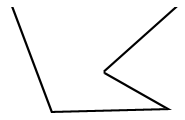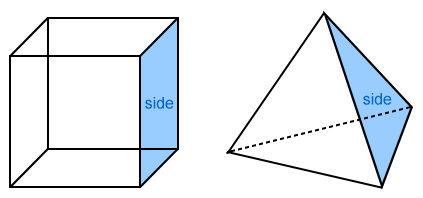Side
In geometry, a side is a line segment or ray in a plane (2D) figure. The face of a space (3D) figure is also referred to as a side.
Sides in 2D figures
In a 2D shape, a side is a line segment or ray that joins a vertex (or vertices). An open or closed shape can contain sides.
Sides of a polygon
The sides of a polygon are the three or more line segments that form the polygon. The following are some examples.

Polygons are usually named based on the number of sides they have. The polygons shown above, from left to right, are a triangle (3 sides), quadrilateral (4 sides), and pentagon (5 sides). A polygon with n sides is called an n-gon.
Sides of an angle or open figure
Each ray or line segment that forms an angle or open figure is called a side.

In the figure above, line segments and are the sides of angle ∠ABC.

There are 4 sides in the open figure above.
What is not considered a side?
An arc or a curve is not considered a side for a 2D figure since neither is a line segment (that is, they are not straight).

The "crescent moon" shaped 2D figure above contains one side and an arc.
Sides in 3D figures
In a 3D shape, the term "side" often refers to a planar face of a figure. The following are some examples of sides in a polyhedron. They are also called the faces of a polyhedron.

Sides of an equation or inequality
In Algebra, an equation or inequality has two sides. Each side is an expression that is often referred to as the left side or right side.
Example:
1. 3x + 4 = 2x - 11
3x + 4 is the left side of the equation and 2x - 11 is the right side of the equation.
2. 5 - 6x > 2 + x
5 - 6x is the left side of the inequality and 2 + x is the right side of the equation.
